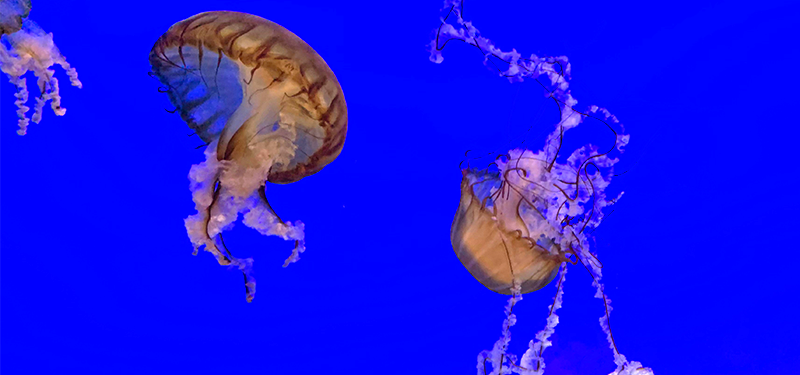The jellyfish is an aquatic invertebrate animal of the phylum Cnidaria. We saw these amazing creatures at the zoo in Newport. This week, Hank and I watched a Mystery Doug blog that answered a question about the creatures that prompted this message. Why do jellyfish sting? I suppose you could guess it is for their protection from predators and a way to immobilize the small fish they consume. The appearance of the jelly is beautiful, graceful, squishy, and obviously harmless. They have no shell, teeth, bones, or brain so they developed defense and food gathering skills in tiny little venomous darts in their tentacles that shoot out when brushed. Most of the venom does not threaten human life but the sting can be painful and itchy. The sea wasp is one of the most deadly, a sting results in excruciating pain and if the sting area is significant, an untreated victim can die in 2 -5 minutes. The wasp carriers enough venom to kill 60 adult humans. My research says the Australian Box Jellyfish may be even more venomous. The only known survivor of a Box jelly is a 10 year old Australian girl. Can you guess which animal kills the most humans each year? The mosquito earns the prize for the many diseases it transmits with its bite. I have to consider humans who ignore science in regard to COVID protection at the top of this list as well.
Back to the jellyfish and their cousins the coral in the ocean. Cnidarian’s are “the builders of some of the richest and most complex ecosystems on our planet, coral reefs.” These simple but complex creatures are an important step in the process of evolution of the nervous systems we see today. Coral can be thought of as an upside down jellyfish in terms of stinging its prey. The reefs are alive and are called ”the rainforests of the sea. They provide a three dimensional habitat for an astonishing variety of plants and animals. Amazingly productive, coral reefs support 25% of all marine life, while occupying only 1% of the ocean floor. Coral is critical to the balance of the ocean’s ecosystem. Coral reefs are in danger today and being degraded by warming water temperatures, climate change, overfishing, ocean acidification, sedimentation and pollution. The reefs produce oxygen for the ocean to thrive. Like so many animals on our planet, the reefs are an endangered natural resource if something is not done quickly to reverse the decline.
A Time Magazine overview of the new book, “The Future We Choose” outlines the world our children and grandchildren can expect in 2050 if the World continues on present course of greenhouse gas-carbon dioxide emissions. It reads like a science fiction horror story, with a barely inhabitable planet. Current climate agreements peg a 45% reduction in emissions by 2030 and zero by 2050. It appears from current trends that emissions will be up by 16% in 2030. The Biden push to build a renewable energy base while moving away from fossil fuels is the only thing to do. The human, financial, and environmental costs of doing little or nothing are well described and scientifically validated. I hope you will keep close watch on the COP26 summit in Glasgow at the end of October. The United States must lead the way on climate change.
Enjoy the end of our beautiful fall weather and wax those skis. Mike
Recent Posts
Categories

